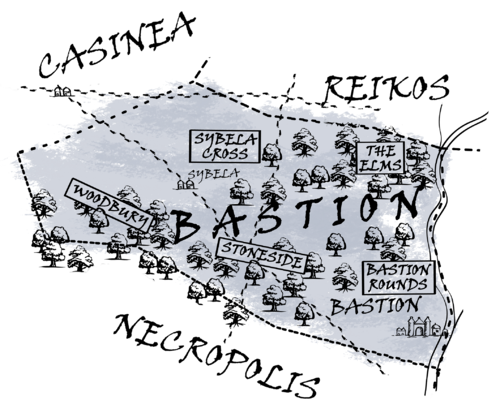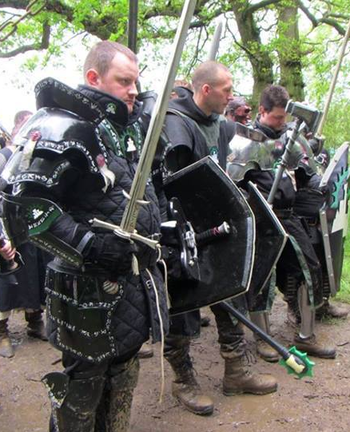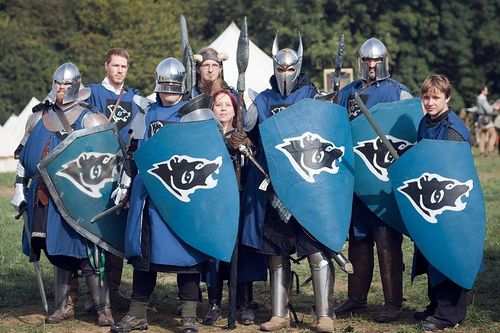Bastion
m (→Stoneside) |
m (→Woodbury) |
||
| Line 40: | Line 40: | ||
===Woodbury=== | ===Woodbury=== | ||
The scattered woodlands here are well maintained, and provide building materials for construction work all over Highguard and beyond. | The scattered woodlands here are well maintained, and provide building materials for construction work all over Highguard and beyond. In the early years of the Empire, Woodbury was extensively forested; three centuries of major construction work have seen most of the old forest disappear leaving a number of [[business|carefully cultivated woodlands]] and a lot of open grassland largely used as pasture. Unlike the chapters of the northern and eastern regions, those of Woodbury tend to be less fortified and more concerned with agriculture and the virtues of [[prosperity]]. Perhaps as a consequence, they tend to be a little wealthier than their counterparts in other parts of the territory. At least one of the chapters here was founded by converts from [[the Marches]], who embraced the piety and strength of Highguard but maintained their deep appreciation for farming and land ownership. | ||
==OOC Notes== | ==OOC Notes== | ||
* Highguard (and thus the Empire) control all the regions of Bastion. | * Highguard (and thus the Empire) control all the regions of Bastion. | ||
Revision as of 17:08, 8 August 2015
Overview
Bastion is the heart of the Highborn nation. The beautiful rolling plains are dotted with woodlands and carefully maintained parks, and with great stone chapterhouses that date back to the first years of the Revelation. Since the end of the Highborn civil war, Bastion has presented the calm, serene visage of the Highborn to the world. During the founding of the Empire, Bastion very nearly became the "official" capital of the Empire in 3YE; at the last minute the Senate decided to hold their quarterly gatherings in Anvil instead.
It was settled in the first years after the founding; but the focus of the early years remained on the southern territory of Pharos. Considered a hinterland where a military presence was neccessary rather than a place to settle, Bastion remained sparesely populated for decades; most settlements were little more than small fortifications along the northern and eastern borders. Things began to change as the first ripples of the Revelation began to shake Highborn society. As the patricians became more and more embroiled in their personal feuds and agendas, the Highborn who would become the founders of the Revelation sought fresh opportunities in Bastion.
The civil war swept across Bastion as well as Pharos, and several chapters were destroyed in the fighting. Several have never been restored, left as reminders of the follies of the past and a warning to the future. Once the war was over, however, the new Assembly of the Virtuous constructed a new city along the banks of the Couros, seeking a new start for their people and their nation.
Recent History
Many refugees from Reikos have made new homes in Bastion over the last decade. Over time a number abandoned their intention to return to Reikos; there is still some friction between established Bastion chapters, Reikos refugees, and those refugees who now consider themselves citizens of Bastion. When the Druj initially conquered Reikos, they launched several strikes across the river into Sybela Cross and the Elms. These were repulsed, but not before bringing down the fortification of the White Tower.
Major Features
Bastion, the White City
The sacred city of Bastion, the White City, is a marvel of marble and mosaic. Even her enemies cannot deny her magnificence – the white marble domes and towers raised up to the demonstrate the glory of a virtuous life, the roads trodden smooth by the footsteps of countless philosophers, warriors and pilgrims. More garden than city, the skyline is dominated by the tall spires and elegant architecture of the huge chapterhouses. The entire city has been expressly designed as a monument to the devotion of the Highborn. When the Imperial Synod recognizes a paragon or exemplar, then a new basilica is constructed here to celebrate their life and deeds.
Few Highborn dwell here permanently but most important folk make a pilgrimage once every year. Every chapter maintains a hostel in the great city, to serve as a dwelling for members who visit. The wealthiest and most powerful Highborn often possess their own residence here, but the city is much more a symbol than it is an active urban centre. During the formation of the League, the citizens of the White City were approached about joining and politely rebuffed. Historians suggest the other cities of the modern League were actually quite relieved - Bastion is a city in name only, and neither it's wealth nor it's population approach that of a major urban centre like Temeschwar or Tassato.
One of the oldest structures in Bastion is the Spire of the Open Hand; in pre-Imperial days, it served as an embassy from the people of Urizen to the people of Highguard. Even after the foundation of the Empire, the spire continued to serve as an embassy until Urizen officially became the ninth nation during the reign of Emperor Giovanni. Today, the three pale towers that made up the spire serve as a combination of school and museum.
Bastion is a site of pilgrimage for followers of the Way but within the city itself are several specific places of note. The ruins of the Lepidean Library, for example, are a valuable lesson of the importance of maintaining Vigilance. A repository of historical information about the lives of paragons and exemplars, it was one of the earliest victims of the rampage of Emperor Nicovar. It has never been rebuilt - today it is maintained as a public park. By contrast, the old meeting halls of the original Highborn assembly, the House of Seven Doors is as beautiful and majestic was it was when it was first completed. Seven chapels, one dedicated to each of the virtues, form an outer ring around a single great hall beneath a white marble dome. The great cathedral stands at the heart of a public park through which seven wide avenues extend, serving as the "spokes" around which the rest of the city was originally arranged. The Highborn still use the House of Seven Doors for important festivities; the duty of overseeing the citadel and it's grounds belongs to the Custos Claves - a ceremonial position named for the ring of keys the Custos Claves notionally holds, each one used to secure one of the gates to the citadel.
Sybela
A small trading town where goods from local farms are sold, Sybela boasts an unusually large number of inns, since it acts as a crossroads for travel between Highguard, the League, Urizen and Dawn. It’s a key stopping point on the pilgrim routes to Highguard. For some, the journey is an important as the destination and Sybela is one place where pilgrims meet, and join together to travel through the still-dangerous lands between the civilised places of the world.
By order of the Imperial Senate, in early 377YE a series of watchtowers and fortified inns were constructed around Sybela following an increase in bandity. The works were overseen by Bridget Eastville (senator for Mitwold) as part of a larger plan to provide protection to towns throughout the Empire. While the defences are not sufficient to qualify Sybela as a fortification, they have already helped reduce brigandry throughout the territory.
Regions
Bastion Rounds
The White City dominates Bastion Rounds. The spires of the city are said to be visible from every part of the region, both the fertile farmlands and the light woods of the north and west. There are few actual chapterhouses here - while most Highborn Chapters maintain a small residence in the city itself, few are actually based here. Those that are are usually concerned with the maintainance and support of the city proper.
The Elms
The Elmwood Forest is the wildest part of Bastion. The chapters established here tend to be a little more introspective than those in the rest of Bastion; several maintain forest preserves while others take advantage of the wild woods to hone their combat and survival skills.
Keywords: Forest
Stoneside
The woodlands of Stoneside cannot really be described as a "forest". Broad avenues are maintained between the trees, and much of the region has the feel of a great park or even orchard, ratehr than a wild wood. Stoneside is hope to several large and prosperous chapterhouses, and also to a special site of pilgrimage. In central Stoneside there is a great rock carved with Wintermark runes, allegedly carried here from Hahnmark by the Exemplar Inga Tarn as part of a pilgrimage of her own. The Burden of Inga Tarn is a common destination for those treading the path of Courage, and represents one of the few "basillicas of the Exemplars" that are not found in the White City itself. Prior to her arrival the region was called East Woods.
Keywords: While there are plenty of trees in Stoneside, the region does not have the forest keyword.
Sybella Cross
Sybella Cross is rich farmland scattered with fortified chapters; some of the oldest in the Empire were founded here in the first diaspora from Pharos. The rich town of Sybela is stands in the south, while in the north the ruins of the fortification known as the White Tower (brought down in 369YE by the Druj) keep an uneasy vigil over the trods that lead north into Reikos. The ruins have been partially restored as part of the ongoing fortification, but the watchtower and pallisade are a poor shadow of the great white granite walls that stood here until the orcs of the Stone Toad clan took them down.
Woodbury
The scattered woodlands here are well maintained, and provide building materials for construction work all over Highguard and beyond. In the early years of the Empire, Woodbury was extensively forested; three centuries of major construction work have seen most of the old forest disappear leaving a number of carefully cultivated woodlands and a lot of open grassland largely used as pasture. Unlike the chapters of the northern and eastern regions, those of Woodbury tend to be less fortified and more concerned with agriculture and the virtues of prosperity. Perhaps as a consequence, they tend to be a little wealthier than their counterparts in other parts of the territory. At least one of the chapters here was founded by converts from the Marches, who embraced the piety and strength of Highguard but maintained their deep appreciation for farming and land ownership.
OOC Notes
- Highguard (and thus the Empire) control all the regions of Bastion.
- Before it's destruction by the Druj, the White Tower was a level one fortification. Built in pre-Imperial times, the fortress was originally level two, but during the time of Empress Mariika it was partially decommissioned - the Senate at the time did not imagine it would ever see action again.


